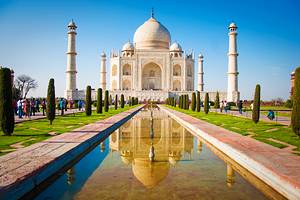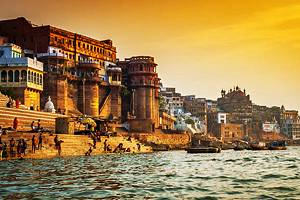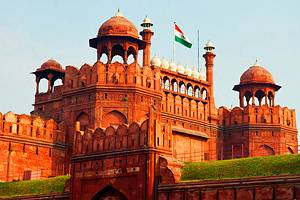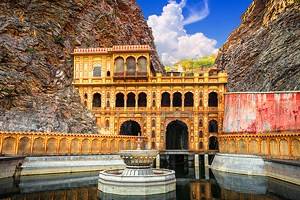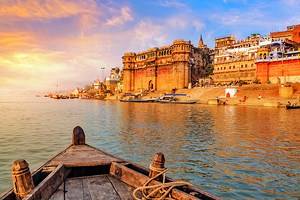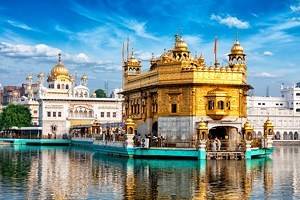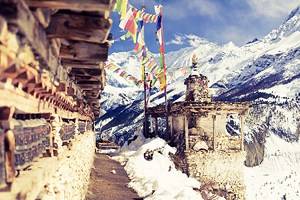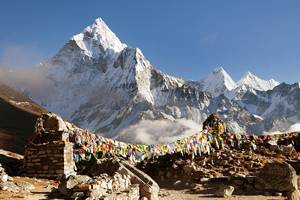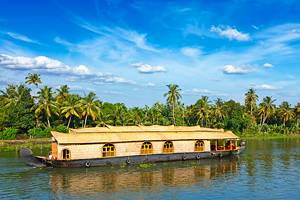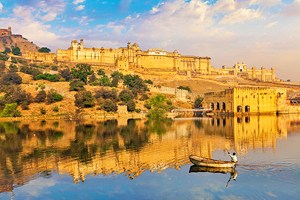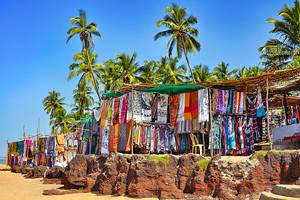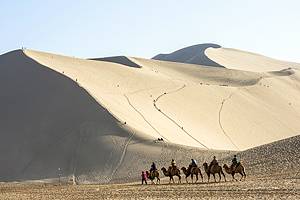Attractions & Places to Visit in Agra
The Taj Mahal is an icon of India and one of the top tourist attractions in the world, drawing millions of visitors to the city of Agra every year. This breathtaking landmark is every bit as incredible as you've imagined. But while most travelers might be eager to escape Agra's pushy touts and exhausting crowds as soon as they've left the Taj Mahal, you should consider sticking around a bit longer.
The Taj Mahal is just one of many amazing places to visit in Agra. While here, you can explore the historically significant Agra Fort; experience the impressively beautiful Tomb of Itimad-ud-Daulah; see one of the largest mosques in India at Fatehpur Sikri; and find respite in Mehtab Bagh, a serene park in the shadows of the Taj.
Animal lovers, take note: Agra boasts two compassionate wildlife projects (the Agra Bear Rescue Facility and the Elephant Conservation and Care Center) that welcome tourists to learn about some of India's most beloved creatures.
Don't let other tourists convince you there's nothing to see in Agra besides the Taj Mahal. Plan your trip to this heritage hot spot with our list of the top attractions in Agra.
- Taj Mahal
- Agra Fort
- Itimad-ud-Daulah's Tomb
- Mehtab Bagh
- Subhash Emporium
- Akbar's Mausoleum
- Fatehpur Sikri
- Agra Bear Rescue Facility
- Elephant Conservation and Care Center
- Agra's Old City
- Gurudwara Guru ka Tal
- Kalakriti Cultural & Convention Center
- Jama Masjid
- Chini ka Rauza
- Map of Attractions & Places to Visit in Agra
Taj Mahal
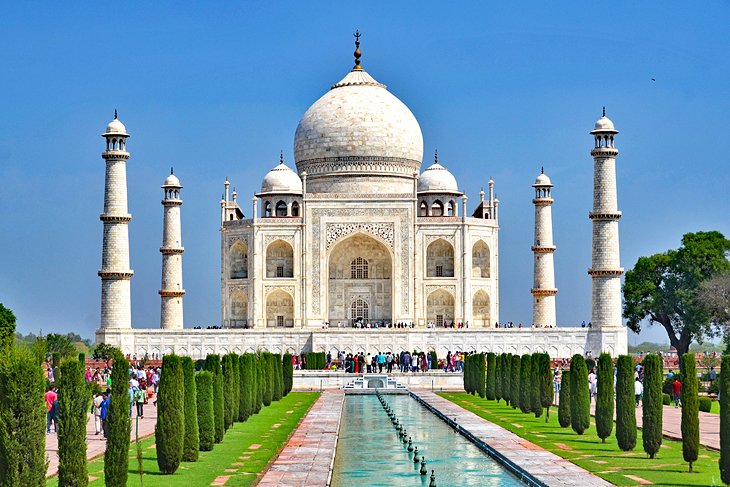
You've seen it in history books, on postcards, and in social media posts. But now, you've made your way to India, and you finally have the chance to see this bucket list destination in real life.
The magnificent structure dates back to the 17th century. Mughal emperor Shah Jahan was heartbroken after his beloved wife, Mumtaz Mahal, passed away during childbirth, and decided to pay tribute to her with a white mausoleum. Construction took more than 20 years to complete and required the manpower of around 20,000 laborers.
There's never a bad time to see the Taj Mahal, but it's worth getting here early–the building seems to radiate at sunrise. Tourists can enter the UNESCO World Heritage Site via the west and east gates. Once inside, explore the ornamental gardens, which feature calming water features that reflect the Taj. Then, head inside the Taj itself and admire its perfect symmetry and white marble with elaborate floral cavings and semiprecious stone inlays.
Sightseeing around the Taj Mahal complex continues at the Kau Ban Mosque, west of the Taj, and the Jawab, a building intended to mirror the mosque and preserve symmetry on the main structure's eastern side.
Hot tip: Hang on to your Taj Mahal ticket–it gives you same-day discounts on entry to other nearby attractions around India, including Fatehpur Sikri and Itimad-ud-Daulah's Tomb.
Address: Dharmapuri, Forest Colony, Tajganj, Agra
Official site: https://www.tajmahal.gov.in/
Agra Fort
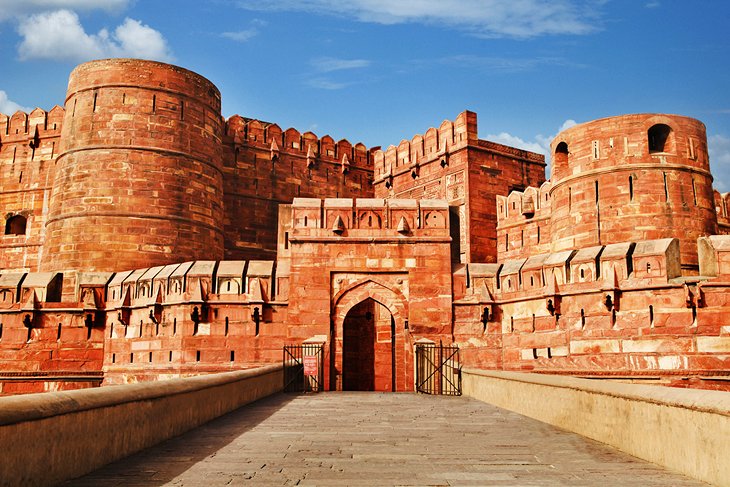
The Taj Mahal isn't the only UNESCO World Heritage Site in Agra–the city is also home to Agra Fort, a centuries-old red sandstone fortress that was once the imperial city for a succession of Mughal rulers.
Sightseeing here is like wandering around a city within a city. The most extraordinary building at Agra Fort is Jahangir Mahal, a massive palace that blends stunning Hindu-inspired features (like overhanging enclosed balconies) with Central Asian architectural elements (such as the signature pointed arches). Inside, tourists can see the gilded central court where royal women once passed their days.
Tourists can also check out a range of other noteworthy structures, including Anguri Bagh (a courtyard with puzzle piece-like outlines of gardens around water channels), Khas Mahal (a palace with pavilions made of white marble and red sandstone), Musamman Burj (an octagonal tower with intricate marble inlay work), and Diwan-i-Khas (a gathering hall featuring a pair of black and white marble thrones).
With so much to see, Agra Fort will require at least a few hours on your itinerary. It makes for a great afternoon stop after a morning at the Taj Mahal.
Itimad-ud-Daulah's Tomb
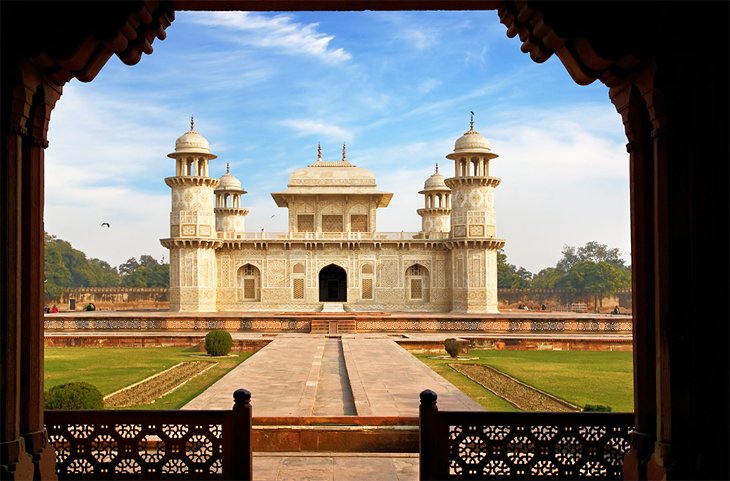
On the banks of the Yamuna River sits another one of Agra's exquisite structures: Itimad-ud-Daulah's Tomb. The mausoleum contains the remains of Mirza Ghiyas Beg, a Persian official who served the Mughal empire, as well as his wife.
Legend has it that this jewelry box-like tomb was actually the inspiration for the Taj Mahal, earning it the nickname "Baby Taj." The red sandstone and marble structure features 13-meter-high hexagonal towers on each corner.
The most noteworthy thing about this attraction, though, is that it was the first structure to use pietra dura, the iconic Indian inlay technique that uses semiprecious stones to create decorative floral designs in marble. You'll see exquisite geometric patterns, depictions of vases and cups, and delicate flower bouquets from floor to ceiling of the graceful structure–reminiscent of those on the Taj Mahal.
Despite its beauty, Itimad-ud-Daulah's Tomb gets far fewer visitors than other attractions around Agra, making it an ideal place to appreciate the lovely features without the crowds.
Address: Moti Bagh, Agra
Mehtab Bagh
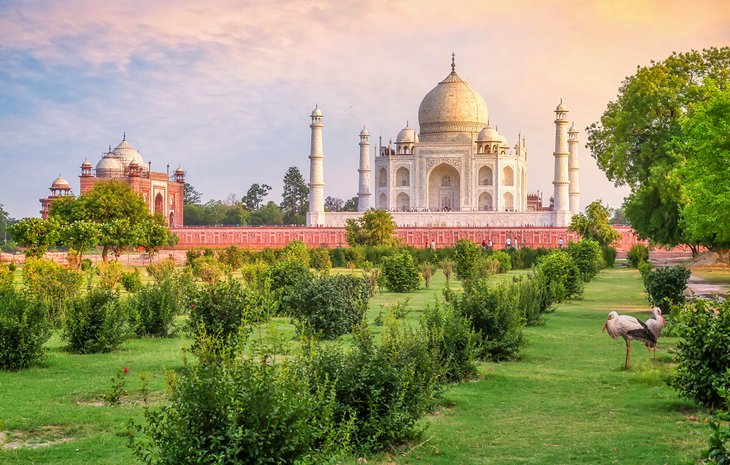
The Taj Mahal almost seems to extend across the Yamuna River at Mehtab Bagh (Moonlight Garden), a square garden complex measuring 300 meters on each side. It's the only remaining park in a series of nearly a dozen Mughal-built gardens in the area.
The park has some pretty flowering trees and bushes–a stark improvement from its state in the mid-1990s, when the site was just a mound of sand. The Archeological Survey of India is hard at work restoring Mehtab Bagh and has already planted Mughal-era plants to help bring the site back to its original glory.
The landscape aligns perfectly with the gardens of the Taj, making it one of the best places in Agra to get a view (or a photo) of the stunning structure–especially at sunset. Outside of the gates to the complex, you can shop for Taj Mahal trinkets and other souvenirs from sellers in the area.
Address: Dharmapuri, Forest Colony, Nagla Devjit, Agra
Subhash Emporium
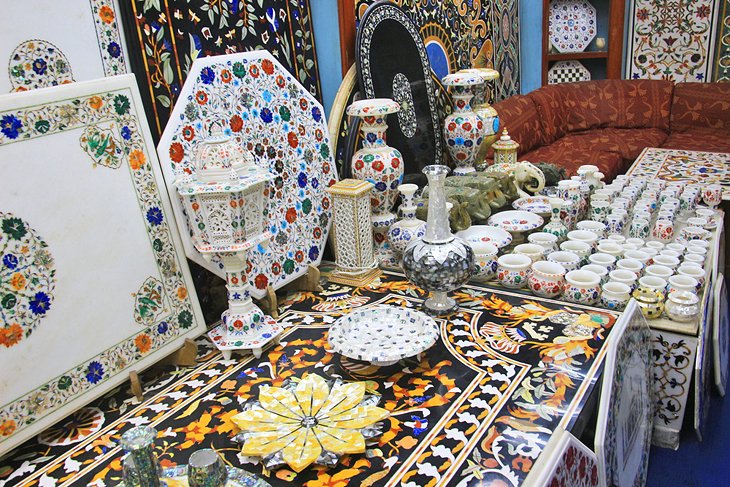
The graceful attractions around Agra will make any tourist fall in love with marble inlay. If you find yourself eager to take a piece of this craftsmanship home with you, head to Subhash Emporium. The boutique has a decades-strong reputation as the go-to place to shop for stone handicrafts in Agra.
Inside, you'll find tons of travel-friendly marble inlay souvenirs, like floral coaster sets, animal statuettes, small boxes, and candle holders. The store also sells larger items, like lamps, tabletops, and carved-marble trays, that it can ship directly to your home.
Even if you don't want to shop, it's worth swinging by Subhash Emporium for its captivating demonstrations–one of the top things to do in Agra. The experienced craftspeople here will show you the precise art of inlaying small pieces of polished stone into hard marble–which might make the high prices of these items seem slightly more reasonable.
Address: 18/1, Gwalior Road, Opp BSNL office, Shahzadi Mandi, Agra
Official site: http://www.marbleemporium.com
Akbar's Mausoleum

For nearly 50 years, emperor Akbar the Great ruled the Mughal kingdom, tripling its empire to include most of the northern half of the Indian subcontinent. His remains (along with those of two of his daughters) can be found at what is now one of the most popular tourist attractions in Agra, Akbar's Mausoleum.
The complex features a marvelous sandstone and marble tomb with striking marble inlay in a variety of colors. The structure is surrounded by Mughal gardens that are home to deer, antelope, monkeys, and even a few peacocks.
If you happen to travel with a compass, whip it out at this site. You'll notice that the tomb faces east–a contrast to nearly all other Mughal tombs, which point toward Mecca.
Address: Sikandra, Agra
Fatehpur Sikri

Just an hour's drive from the Taj Mahal, Fatehpur Sikri makes for a worthwhile day trip from Agra. The city, once the capital of the Mughal Empire some 500 years ago, was built by Akbar as a salute to the famous Sufi saint, Shaikh Salim Chishti, who accurately predicted the birth of an heir. Residents abandoned the city not long after it was built, when water supplies ran too low.
Tourists can now explore the well-preserved remains of this red sandstone ghost town, still surrounded by a fortification wall. Check out the Jama Masjid, a mosque and one of the first buildings finished in the city. Then, explore the three palaces, built for each one of Akbar's wives. They combine a variety of religious-inspired architectural styles that honor the women's individual spiritualities.
Finally, get off the beaten path and stroll to Hiran Minar, a circular spiked tower covered with stone elephant tusks, atop which Akbar himself supposedly gazed at wildlife.
Dig in deeper to this incredible site with a visit to the Archaeological Museum, near the Diwan-i-Am main gate. It contains four galleries filled with treasures from the Mughal era and beyond, including grey ware pot shreds, terra-cotta lamps, mini human heads in stone, jewelry molds, and much more.
Agra Bear Rescue Facility

Between its reverence for cows and its temples dedicated to specific creatures, India has a fascinating relationship with animals. But not every tradition has been kind to four-legged creatures. Case in point: Dancing sloth bears.
For thousands of years, India's Kalandar community has poached sloth bear cubs, driven a red hot poker and coarse rope through their muzzles and yanked on the string to force them to put on painful "performances" for a paying audience. India prohibited the cruel practice in 1972. However, the mistreatment continued–leaving animal rights activists, such as Wildlife SOS, to save the victimized bears.
You can see around 130 of these rescued dancing bears playing, foraging, and climbing trees at Agra Bear Rescue Facility. Visits to the center include a tour guided by an expert who can shed light on India's vanishing wildlife and conservation efforts. It's an insightful experience, and all proceeds go toward rehabilitation efforts.
Address: Inde, National Highway 2, Muranda, Agra
Official site: https://wildlifesos.org/locations/agra-bear-rescue-facility/
Elephant Conservation and Care Center
Sloth bears aren't the only focus for Wildlife SOS–the animal protection organization also takes care of abused elephants at a sanctuary just 30 kilometers outside of Agra. On tours of the facility, you can see more than 20 rescued elephants that were forced to work in harsh conditions. Lucky tourists may even be invited to help prepare lunch for the tusked mammals.
While you will definitely have other opportunities to interact with elephants on your trip to India, visiting the Elephant Conservation and Care Center is by far one of the most ethical (and fulfilling) ways to get up close to these special creatures.
Address: Near Sachdeva Institute of Technology Thurmura Ghari, NH2, Mathura
Official site: https://wildlifesos.org/locations/elephant-conservation-and-care-centre/
Agra's Old City
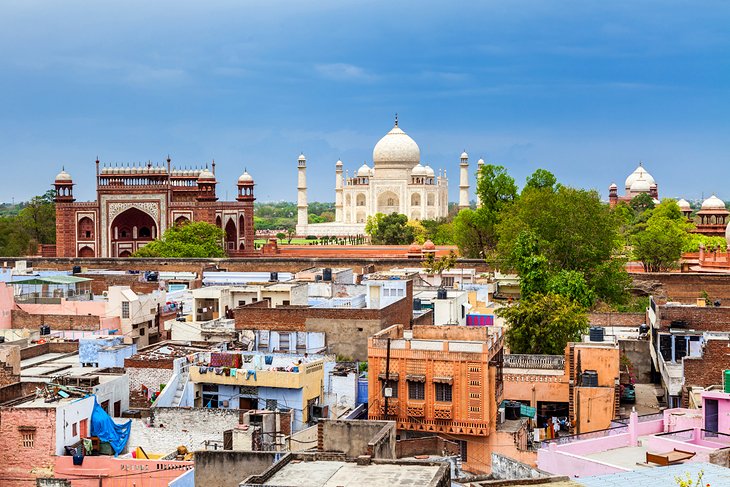
For an authentic look at the life of Agra's present-day residents, take an organized walking tour around the Old City. The excursion teaches tourists about Agra's architecture, history, culture, and street food as they wander around the neighborhood.
You'll get the chance to see what everyday life is like for Agra locals, learn where to go for the best views of the Taj Mahal, and stop by the bustling wholesale spice market for an explosion of color and aroma. Come hungry–the tour guide will also take you to Agra's oldest sweet shop for some treats.
Gurudwara Guru ka Tal
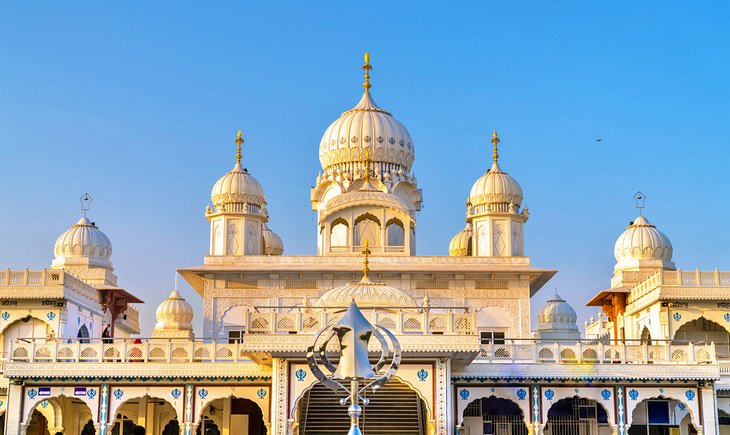
Mughals may have spread Islam throughout this part of India, but the region around Agra is also home to a devout Sikh community. Many of them make pilgrimages to Gurudwara Guru ka Tal, a spiritual center near Agra.
This peaceful place was built in the 17th century, and modern-day tourists can see the eight towers that remain of the structure's original dozen. Tourists can also enjoy free meals from the community kitchen–perfect for refueling before a trip back to the city.
Address: Chennai-Delhi Highway, Maharishi Puram Colony, Agra
Official site: http://www.gurdwaragurukataal.com/
Kalakriti Cultural & Convention Center
The Kalakriti Cultural & Convention Center is on a mission to deepen tourists' appreciation of Indian art and culture. Every evening at 6:30pm, it puts on a performance of "Mohabbat-the-Taj: The Saga of Love," a dramatic musical that brings the legendary love story of the Taj Mahal to life. Expect Bollywood-inspired dance and song throughout the hour-long show. Afterward, head to the center's handicrafts showroom to shop for intricately designed marble inlay souvenirs and other treasures.
Address: 41/142, A/1 VIP Road-Taj Mahal Road, Fatehabad Road., Agra
Jama Masjid
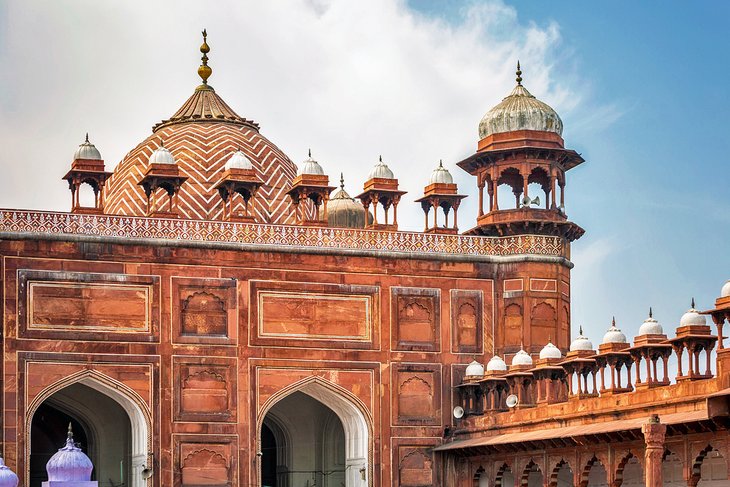
One of India's largest mosques can be found in the historic core of Agra, just across from the Agra Fort. Still the city's principal mosque, the Jama Masjid was built during the 17th century under the reign of Mughal Emperor Shah Jahan. The striking red sandstone structure stands atop a platform, and features remarkable white marble inlay with blue-washed ceilings and walls. Throughout the interior, tourists can see graceful inlaid panels similar to those at the Taj Mahal.
The Friday prayer service draws massive crowds to the Jama Masjid, but outside of that time, it's relatively empty. The mosque encourages tourists to observe silence when visiting this sacred place.
Address: Jama Masjid Road, Kinari Bazar, Hing ki Mandi, Mantola, Agra
Chini ka Rauza
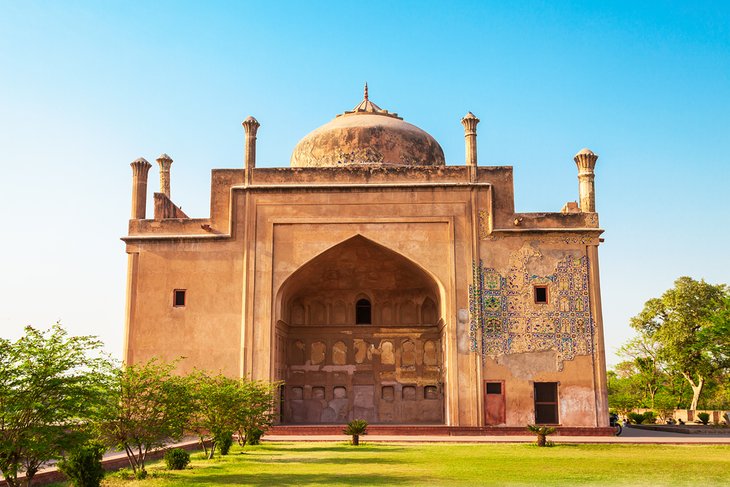
After visiting Itimad-ud-Daulah's Tomb, head one kilometer north to see Chini ka Rauza, a funerary monument that houses the tomb of Afzal Khan Shirazi, who served as the prime minister for Mughal Emperor Shah Jahan.
While not nearly as well preserved as other attractions in Agra, the Indo-Persian structure is noteworthy for being the first monument to feature chini, a distinctive decoration made from turquoise, yellow, green, and orange glazed tiles. As the name of the building suggests, each of its tiles were imported from China–an impressive feat during the 17th century, when this monument was constructed. Step inside Chini ka Rauza to see an array of detailed paintings and Islamic inscriptions.
After visiting the Chini ka Rauza, you can take a 10-minute walk south to see the ruins of the Tomb of Sultan Parwiz, who was the brother of Shah Jahan.
Address: Katra Wazir Khan, Agra
Map of Attractions & Places to Visit in Agra
More Related Articles on PlanetWare.com
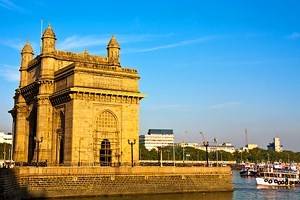
Places to Visit in India: India is filled with incredible sights and cities and planning a trip here can be a bit daunting. If you are just getting started on your itinerary, have a look at our guide to the Attractions in India. Most visitors will transit through either Mumbai or Delhi, both of which are home to a long list of things to see and do.


